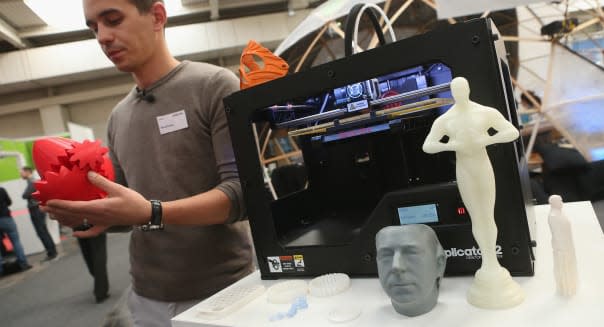Your Household Is Just a Few Years Away from a 3-D Printed Future

Beep beep beep. Beep beep beep.
You turn off your alarm and jump in the shower. Noticing your razor's missing, you tell your phone to find a quick design and send it to your 3-D printer. You also see your leather belt is beginning to crack, so you queue up a replacement.
The razor is ready when you jump out of the shower, so you shave and dress, then head to the kitchen.
While you're pouring a cup of coffee, your son asks if you picked up a padlock for his gym locker. You forgot, but queue one up. Fortunately, it finishes just as he's heading out to catch the bus.
Making your way to your home office, you discover another problem. The beer you started enjoying last night while sending a few emails spilled all over your keyboard, which is no longer working. Must've been that darn cat! You use your smartphone to tell the 3-D printer to queue up a new keyboard as you check your schedule on your tablet.
There's a reminder that you have a dentist appointment in an hour (a tooth is likely printing right now to replace one pulled last week). Then you're reminded that your anniversary is next week. You check your wife's online wish list and locate a silk scarf she's been eyeing, then schedule it to be fabricated next week.
Walking out to your car (which was printed on industrial 3-D printers, engine included), you notice the side-view mirror is loose. You ask your phone to identify the correct missing bolt and print out the new threaded screw. It's done in minutes.
And, with that, you're out the door.
Science Fiction and Reality Are Starting to Meet
Believe it or not, every single item mentioned in the scenario above is an object that has already been manufactured using a 3-D printer. The more complex items require printers designed for industrial work. But many of the smaller ones can be produced by consumer 3-D printers that are already available for sale.
%VIRTUAL-article-sponsoredlinks%While today's printable objects may not be perfect, over the next few years, the process will be fine-tuned, and eventually, objects printed at home will be on par with those made in factories. And, as the costs come down, it's not unreasonable to expect the 3-D printer to become a common household appliance.
In fact, this trend is already under way.
In 2013 alone, 3-D printer shipments were on pace to grow 49 percent according to research firm Gartner. Shipments will increase another 75 percent in 2014, then double in 2015, according to Gartner's estimates. Corporate giants like General Electric (GE) predict 3-D printers will "touch" half of their manufacturing within the next two decades.
Of course, 3-D printing won't be used for everything in the house. (It's unlikely most households will have one large enough to print a new bookshelf or recliner, for example.) But for the little things -- screws that are lost, cellphone cases that don't fit your hand just right, customizable anything, really -- 3-D printing will soon become the norm.
Today's Cool Gadget; Tomorrow's Dust Magnet?
Researchers from Michigan Technological University recently looked at the economic life cycle of a home 3-D printer. They compared the cost of 20 common household items purchased online (excluding shipping) versus the costs associated with creating them at home, out of plastic, with a 3-D printer.
They concluded that the average household would save between $300 and $2,000 a year by utilizing a home 3-D printer, and that with modest use, a printer will "pay for itself" within four months to two years. Even more impressive, you'll be able to print out parts of the printer that are most likely to wear out with use, preventing you from having to buy a new machine unless you really want to.
Now, isn't it easier to imagine how a 3-D printer will affect your life in the future? Can't find that garlic press and the in-laws are coming over for dinner tomorrow? Print up a new one for $1.61 (the costs calculated by the Michigan Technological University researchers, electricity included). Left your iPad stand at work? Print a home version for just 41¢. Forgot about your nephew's birthday? Print him a toy train for 40¢ and have it ready before you walk out the door.
Motley Fool contributor Adam Wiederman has no position in any stocks mentioned. The Motley Fool owns shares of General Electric. Try any of our Foolish newsletter services free for 30 days.

